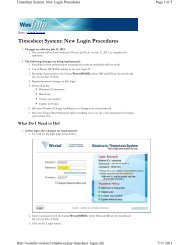The Addiction Behaviors Checklist: Validation of a New ... - Westat
The Addiction Behaviors Checklist: Validation of a New ... - Westat
The Addiction Behaviors Checklist: Validation of a New ... - Westat
Create successful ePaper yourself
Turn your PDF publications into a flip-book with our unique Google optimized e-Paper software.
348 Wu et al.Vol. 32 No. 4 October 2006variances not assumed, there was a significantdifference between these two groups at thefinal visit (t(47) ¼ 2.40, P ¼ 0.021).Correlations Between ABC Scoresand Pain ScoresIn the presence <strong>of</strong> pseudoaddiction, onemight expect that ABC scores would tend tocovary with pain scores (i.e., as patient receivesadequate pain relief and pain scores decrease,pseudoaddictive behaviors would decrease aswell). Table 2 displays correlation coefficientsbetween mean ABC scores and both usualand worst pain scores at the quarterly visit.This analysis found no significant correlationsbetween ABC scores and pain scores. This findinglends support to the concept that increasesin ABC scores would be indicative <strong>of</strong> inappropriatebehaviors suggestive <strong>of</strong> addiction ratherthan a pseudoaddiction process.Discussion<strong>The</strong> goal <strong>of</strong> this study was to test the psychometricproperties <strong>of</strong> the ABC, a new instrumentfor tracking behaviors suggestive <strong>of</strong>addiction related to opioid medications inchronic pain populations. <strong>The</strong> ABC showsstrong interrater correlations across three separateinterviewers, supporting the reliabilityand objective nature <strong>of</strong> the individual itemsand total score. <strong>The</strong> ABC total score alsoshowed good concurrent validity in terms <strong>of</strong>Table 2Pearson Correlation CoefficientsBetween Mean ABC Scores and Usual Pain Scoreat Quarterly Visit PointsABC Mean ScoreInitialVisit4-MonthVisit8-Month 12-MonthVisit VisitUsual pain, initial visit 0.12 0.05 0.01 0.05Usual pain,0.12 0.04 0.04 0.024-month visitUsual pain,0.1 0.08 0.01 0.058-month visitUsual pain,0.12 0.09 0.00 0.1212-month visitWorst pain, initial visit 0.12 0.10 0.09 0.10Worst pain,0.16 0.06 0.04 0.024-month visitWorst pain,0.13 0.04 0.05 0.058-month visitWorst pain,12-month visit0.23 0.06 0.10 0.13its relationship with global clinical judgments<strong>of</strong> appropriate opioid use, as well as validitywith an opioid misuse risk assessment instrument,the PDUQ, which itself has shown verygood preliminary external validity. 16 <strong>The</strong> sensitivityand specificity analysis indicates thata cut-<strong>of</strong>f score <strong>of</strong> 3 or more on the ABC providesa good general estimate <strong>of</strong> appropriatevs. inappropriate opioid use. This cut-<strong>of</strong>f scoreshowed initially positive results in differentiatingopioid abuse as assessed by the PDUQ.Comparison with Other Measures<strong>The</strong> ABC can be distinguished from otherrecently developed instruments in this areain that it is specifically focused on longitudinalassessment and tracking <strong>of</strong> problematic behaviorsand not determination <strong>of</strong> risk. <strong>The</strong>re arenow several published measures for use withchronic pain patients to assess risk <strong>of</strong> opioidmisuse or addiction. 13,14,16 <strong>The</strong>se measures includehistorical information (e.g., history <strong>of</strong>substance abuse), current nonopioid abuse behaviors(e.g., nicotine craving), and opioidmedication-related behaviors. <strong>The</strong> focus onhistorical information is critical for assessment<strong>of</strong> risk since previous substance abuse can bepredictive <strong>of</strong> future opioid abuse. 15,18 <strong>The</strong> nature<strong>of</strong> these scales, however, makes them lesslikely to change over time and they are notdesigned to track signs <strong>of</strong> misuse or flagbehaviors that signal increasing medicationproblems. Additionally, even though certainpredictors have suggested an increased riskfor future opioid abuse, the data indicatethat the prediction models are not highly robustand presence <strong>of</strong> these predictors doesnot provide certainty that chronic pain patientswould misuse their opioid medicationsin the future. For example, Compton et al. 16found that in a sample <strong>of</strong> 52 chronic pain patientsevaluated for opioid addiction, 27%and 50% <strong>of</strong> those who did not meet addictioncriteria still had a positive personal history andfamily history <strong>of</strong> addictive disease, respectively.This suggests that history variables, while cautionary,may not be clear enough indicatorsto withhold or modify opioid treatment decisions.On the other hand, the ABC representsthe first measure specifically designed and validatedfor longitudinal assessment <strong>of</strong> behaviorssuggestive <strong>of</strong> addiction. Because addictivedisease is essentially a disease <strong>of</strong> behavior, we







